Lucius Quinctius Cincinnatus
| Lucius Quinctius Cincinnatus | |
|---|---|
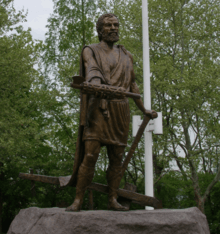 | |
| Consul of the Roman Republic | |
|
In office 460 BC | |
| Preceded by | Publius Valerius Publicola and Gaius Claudius Inregillensis Sabinus |
| Succeeded by | Quintus Fabius Vibulanus and Lucius Cornelius Maluginensis Uritinus |
| Dictator | |
|
In office 458 BC | |
| Dictator | |
|
In office 439 BC | |
| Personal details | |
| Born |
519 BC Kingdom of Rome |
| Died |
430 BC (aged c. 89) Roman Republic |
| Spouse(s) | Racilia |
| Religion | Ancient Roman religion |
| Military service | |
| Allegiance |
|
| Rank | General |
| Battles/wars | Battle of Mons Algidus |
Lucius Quinctius[1] or Quintius[2] Cincinnatus (c. 519–430 BC) was a Roman patrician, statesman, and military leader of the early Republic who became a legendary figure of Roman virtues—particularly Roman manliness and civic virtue—by the time of the Empire.
Supposedly, Cincinnatus was a conservative opponent of the rights of the plebeians who fell into penury because of his son's violent opposition to their desire for a written code of equitably-enforced laws. Despite his old age, he worked his own small farm until an invasion prompted his fellow citizens to call for his leadership. He came from his plough to assume complete control over the state but, upon achieving a swift victory, relinquished his power and its perquisites and returned to his farm. His success and immediate resignation of his near-absolute authority with the end of this crisis (traditionally dated to 458 BC) has often been cited as an example of outstanding leadership, service to the greater good, civic virtue, lack of personal ambition, and modesty. As a result, he has inspired a number of organizations and other entities, some named in his honor.
Modern historians question some particulars of the story recounted in Livy and elsewhere but usually accept Cincinnatus as a historical figure who served as suffect consul in 460 BC and as dictator in 458 BC and (possibly) again in 439 BC, when the patricians called on him to suppress the feared uprising of the plebs under Spurius Maelius.
Life

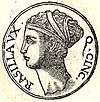
According to the traditional accounts, Lucius would have been born about 519 BC,[3] during the last decade of the Roman Kingdom. He would have been a member of the lesser patrician clan (minor gens)[4] Quinctia, whom Tullus Hostilius supposedly moved to Rome from the Latian city of Alba Longa.[5] The clan's first consul was Titus Quinctius Capitolinus Barbatus, elected in 471 BC.[6] As both Titus and Lucius are recorded as the son and grandson of men named Lucius Quinctius, Titus is sometimes thought to have been Lucius's brother. This suggests Lucius was the first of his cognomen Cincinnatus, meaning "the curly haired".[1] The family was relatively rich.[2]
In the late 460s BC, Rome was fending off raiding by the Aequi to their east and, beginning in 462 BC, the tribune G. Terentilius Harsa began pressing for codification of the Roman laws in order to establish a kind of constitution that would check the near-regal power of the patrician consuls. In the years that followed, he and the other plebs were ignored, fended off, rejected on procedural grounds, and finally beaten and driven from the streets by gangs of patricians and their clients, supposedly including Cincinnatus's son Caeso.
The violent resistance of the patricians to such a blameless request prompted so much unrest that Appius Herdonius was able to seize the Capitoline Hill and hold it against the city with a gang of outlaws and rebel slaves (in Livy) or with an army of Sabines (in Dionysius).[7] The consul Publius Valerius Poplicola was killed in its recovery in 460 BC[2] and Cincinnatus, probably illegally,[8] became the suffect ("replacement") consul for the remainder of the year. Cincinnatus was himself a violent opponent of the plebs' proposal,[8] which made no progress during his administration. His son, however, was supposedly driven from town and killed[8] for his murder of a plebeian.[9] Cincinnatus quit the city and retired to an estate he held to the west of the Tiber.[2]
He served as dictator, a king-like figure appointed by the Republic in times of extreme emergency, in 458 or 457 BC in order to lead reïnforcements to the defense of the Roman army under the consul L. Minucius Esquilinus Augurinus at Mount Algidus.[lower-alpha 1] Many of the details of the story are now assumed to be spurious[8] and some consider the entire military account ahistorical, believing its parallels with T. Quinctius Cincinnatus's 380 BC defeat of Praeneste[11] and Fabius the Delayer's 217 BC rescue of M. Minucius Rufus from Hannibal[12] too great for chance.[13] Cincinnatus is recorded, however, having taken advantage of his position as dictator—however gained—to ignore the objections of the tribunes and to charge his son's accuser Marcus Volscius for perjury, driving him into exile.[8][lower-alpha 2]
During the decemvirate, he ran unsuccessfully for a position in their government in 450 BC[8][14] but Livy notes his involvement in the discussion about opening the consulship to plebeians.[15]
Possibly, he returned as dictator in 439 BC to defend Rome against the conspiracy the prefect L. Minucius Augurinus alleged Spurius Maelius was plotting against the Republic. When Spurius Maelius ignored his summons, however, he was killed by Cincinnatus's master of horse and any plot collapsed.[16] He presumably died sometime soon afterward.[2]
Legend
Son
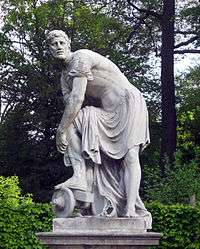
In the traditional accounts of the story, Cincinnatus's son Caeso was an openly violent opponent of the attempts of the plebeians to enact the Terentilian Law, which sought codifying the Roman legal tradition and circumscribing the authority of the patrician consuls. Caeso would lead gangs to drive the tribunes of the plebs from the forum, disrupting the procedures necessary to approve it. He was brought up on capital charges in 461 BC but released on a large bail. A plebeian named Marcus Volscius testified that his brother, while feeble from sickness, had been knocked down and injured by Caeso with such force that he later died.[2] Rather than face his accusers in court, Caeso fled to the Etruscans. He was then condemned to death in absentia and his father subjected to a huge punitive fine, forcing him to sell most of his estates and to retire from public life to personally work a small farm.[17] (Some accounts say Caeso was killed with Poplicola in the recovery of the Capitoline from Herdonius.)[2] Modern historians particularly reject the fine as a later invention inserted to explain the dictator's supposed poverty and heighten his virtues.[8][1] Some reject the story in its entirety.[18]
First Dictatorship

In 458 BC, the Aequi to Rome's east broke their treaty of the year before and attempted to retake Tusculum (Frascati). The consuls for the year—L. Minucius Esquilinus Augurinus and G. Nautius Rutilus—led out two armies, one to Tusculum's relief and another to strike against the lands of the Aequi and their Sabine allies. Upon reaching Mount Algidus in the Alban Hills, the army under L. Minucius Esquilinus Augurinus encamped and rested instead of immediately attacking. The Aequi quickly deployed around their position and successfully besieged them, with only a five horsemen escaping[2] to tell the Roman Senate what had happened. With the army of the second consul unable to help, the senators fell into a panic and authorized the nomination of a dictator. G. Nautius Rutilus or Horatius Pulvillus named Cincinnatus for a term of six months.[19]
A group of senators were sent to Cincinnatus to inform of him of his appointment, finding him while he was ploughing his farm.[lower-alpha 3] He asked them, "Is everything all right?" and they replied that they hoped "it might turn out well for both him and his country", asking that he don his senatorial toga before hearing the senate's mandate. He then called out to his wife Racilia, telling her to bring his toga from their cottage.[19] Once he was properly dressed, the delegation hailed him as dictator and ordered him to come to the city. He crossed the Tiber in one of the senate's boats and was greeted on his return by his three sons and most of the senators. Several lictors were given to him for protection and enforcement of his orders.
The next morning, Cincinnatus went to the forum and named Lucius Tarquitius as his master of the horse.[2] He then went to the assembly of the people and ordered every man of military age to appear on the Field of Mars (Campus Martius) by the end of the day[21] with twelve times the normal amount of encamping spikes. They then marched to the relief of the consul's relieving army. At the Battle of Mt Algidus, they used their spikes to quickly besiege the besieging Aequi. Rather than slaughter them between the two Roman camps, however, Cincinnatus accepted their pleas for mercy and offered an amnesty provided that three principal offenders be executed and Gracchus Cloelius and their other leaders be delivered to him in chains. A "yoke" of three spears was then set up and the Aequi made to pass under it as an act of submission, bowing and admitting their defeat. Cincinnatus then disbanded his army and returned to his farm, abandoning his control a mere fifteen days after it had been granted to him.[22]
Second Dictatorship
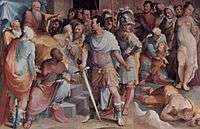
On the nomination of his brother or nephew Titus Quinctius Capitolinus Barbatus, Cincinnatus came out of retirement for a second term as dictator in 439 BC to deal with the feared plot of the wealthy plebeian Spurius Maelius to buy the loyalty of the poor and establish himself as king over Rome. Cincinnatus named C. Servilius Ahala his master of the horse and directed him to bring Spurius Maelius before him. He and the other patricians then garrisoned the Capitoline Hill and other strongholds around the city. Maelius fended off Ahala's officer with a butcher's knife and fled into a crowd. Ahala led a band of patricians into the crowd and killed him during his flight. With the crisis resolved, Cincinnatus again resigned his commission, having served 21 days. (Ahala was later brought to trial for exceeding his commission and accepted voluntary exile.)[2] Various aspects of the story are connected with dubious etiological legends and it may have no more connection to the dictator of 458 BC than the fact that the consul for the year was a member of the same clan.[23]
Other legends
Cincinnatus became a legend to the Romans. Twice granted supreme power, he held onto it for not a day longer than absolutely necessary. The high esteem in which he was held by the later Romans[20] is sometimes extended to his compatriots. One legend from the end of his life claims a Capitolinus defended one of his sons from a charge of military incompetence by asking the jury who would go to tell the aged Cincinnatus the news in the event of a conviction. The son was said to have been acquitted because the jury could not bring itself to break the old man's heart.
Legacy

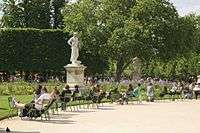
Many Italian cities have plazas, streets, or other locations named for Cincinnatus (Italian: Cincinnato). The Cincinnato neighborhood in Anzio, Italy, and Cincinnatus, New York, in the United States[25] are named in his honor.
The Society of the Cincinnati was established by Henry Knox in 1783 to assist the officers of the Continental Army and Navy and their families; to preserve the ideals of the American Revolution; and to maintain the union of the former colonies. A French Society of the Cincinnati was founded soon afterwards by King Louis XVI. Cincinnati, Ohio, long one of the major cities of the United States, was named in its honor.[24]
The legend of Cincinnatus's selfless service for his country has continued to inspire admiration, including by Niccolò Machiavelli.[26] It has also been invoked to honor other political leaders, notably George Washington. Washington's relinquishing of control of the Continental Army, refusal to consider establishing a monarchy or assuming monarchical powers, and voluntary retirement after two terms as president to return to his farm at Mount Vernon have made allusions to Cincinnatus common in historical[27] and literary[lower-alpha 4] treatments of the era.
The legend has also inspired or influenced some fictional characters. Maximus Decimus Meridius (played by Russell Crowe) in the year 2000 movie Gladiator began as a portrayal of the wrestler Narcissus[29] but the repeated rewrites before the final script led some to compare him to Cincinnatus.[lower-alpha 5]
See also
- Quinctia, the Roman clan
- List of Roman dictators
- Horatii
- Marcus Atilius Regulus
- Cato the Elder
- Publius Decius Mus
Notes
- ↑ Cicero, apparently mistakenly, places these events in Cincinnatus's second dictatorship.[10]
- ↑ The accusations against Volscius are sometimes placed in 459 BC and credited to the patricians as a class, rather than to Cincinnatus himself, although this seems to have been a later fabrication.[2]
- ↑ This story is sometimes told of his election as consul.[20]
- ↑ For example, in Lord Byron's 1814 "Ode to Napoleon Buonoparte".[28]
- ↑ For example, reviewer Nick Powell[30] and academics Michael Sleasman[31] and Page DuBois.[32]
References
Citations
- 1 2 3 EB (1911).
- 1 2 3 4 5 6 7 8 9 10 11 AC (1879).
- ↑ EB (1878), p. 784.
- ↑ Niebuhr, History of Rome, Vol. II, pp. 291–2.
- ↑ Livy, History, I, §30.
- ↑ DGRB&M (1867), Vol. III, "Qui′ntia Gens".
- ↑ Forsythe (2006), p. 205.
- 1 2 3 4 5 6 7 DGRB&M (1867), Vol. I, "Cincinna′tus".
- ↑ EB (1878), p. 748.
- ↑ Cicero, On Old Age, §16.
- ↑ Livy, History, VI, §§28–29.
- ↑ Livy, History, XXII, 23–30.
- ↑ Forsythe (2015), p. 319.
- ↑ Livy, History, III, §35.
- ↑ Livy, History, IV, §6.
- ↑ Livy, History, IV, §13–5.
- ↑ Livy, History, III, §14.
- ↑ Forsythe (2006), p. 204.
- 1 2 Livy, History, III, §26.
- 1 2 NSRW (1914).
- ↑ Livy, History, III, §27.
- ↑ Livy, History, III, §§28–9.
- ↑ Forsythe (2006), p. 240.
- 1 2 Encyclopædia Britannica, 9th ed. (1878), Vol. V, "Cincinnati".
- ↑ "U.S. is Full of Odd and Wonderful Names", Life, Vol. 16, No. 5, Chicago: Time Inc., 31 January 1944, p. 57.
- ↑ Heller, Agnes (2015), Renaissance Man, Abingdon: Routledge, p. 415.
- ↑ Cramer, Ruby (16 January 2015), "'Team Cincinnatus': Tom Steyer Draws Name from Roman Dictator", BuzzFeed News, New York: Buzzfeed.
- ↑ Byron, George Gordon (1814), "Ode to Napoleon Buonaparte", §XIX.
- ↑ Larsen, Andrew E. (15 August 2014), "Gladiator: Anatomy of a Composite Character", A Historian Goes to the Moves.
- ↑ Powell, Nick (6 August 2013), "Who Was the Real Maximus?", The Cinematic Katzenjammer.
- ↑ Sleasman, Michael J. (2007), "Swords, Sandals, and Saviors: Visions of Hope in Ridley Scott's Gladiator", Everyday Theology: How to Read Cultural Texts and Interpret Trends, Cultural Exegesis, Baker Academic, pp. 270–1.
- ↑ DuBois, Page (2009), Slavery: Antiquity & Its Legacy, Oxford: Oxford University Press, p. 113.
Bibliography
Primary sources
- Dionysius of Halicarnassus Roman Antiquities, Book X, §§ 23–25.
- Florus, Epitome of Roman History, Book I, § 11.
- Livy, History of Rome, Book III, §§ 26–29.
- Pliny the Elder, Natural History, Book XVIII, § 4.
Secondary sources
- "Lucius Quintius Cincinnatus", American Cyclopaedia, Vol. IV, New York, 1879.
- "Cincinna′tus", A Dictionary of Greek and Roman Biography and Mythology, Vol. I, Boston: Little, Brown, & Co., 1867.
- "Lucius Quinctius Cincinnatus", Encyclopedia Americana, Vol. VI, New York, 1920.
- "Cincinnatus", Encyclopædia Britannica, 9th ed., Vol. V, New York: Charles Scribner's Sons, 1878, pp. 784–5.
- "Lucius Quinctius Cincinnatus", Encyclopædia Britannica, 11th ed., Vol. VI, Cambridge: Cambridge University Press, 1911, p. 374.
- "Lucius Quintius Cincinnatus", New Student's Reference Work, Vol. I, Chicago: F.E. Compton & Co., 1914.
- Forsythe, Gary (2006), A Critical History of Early Rome: From Prehistory to the First Punic War, Berkeley: University of California Press.
- Forsythe, Gary (2015), "The Beginnings of the Republic from 509 to 390 BC", A Companion to Livy, Chichester: John Wiley & Sons, pp. 313–329.
External links
| Wikimedia Commons has media related to Lucius Quinctius Cincinnatus. |
- Cavazzi, F. (12 April 2012), "The Early Roman Republic", Illustrated History of the Roman Empire.
- Gill, N.S. (17 August 2016), "Lucius Quinctius Cincinnatus", About Ancient/Classical History, About.com.
| Political offices | ||
|---|---|---|
| Preceded by Publius Valerius Publicola, and Gaius Claudius Sabinus Regillensis |
Consul (Suffect) of the Roman Republic 460 BC with Gaius Claudius Sabinus Regillensis |
Succeeded by Quintus Fabius Vibulanus and Lucius Cornelius Maluginensis Uritinus |